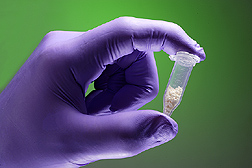This page has been archived and is being provided for reference purposes only. The page is no longer being updated, and therefore, links on the page may be invalid.
|
Read the magazine story to find out more. |
|
|
Searching for Soy's Secret, Yet Promising, Compounds
By Erin PeabodyJanuary 9, 2006
You may not be a huge fan of tofu now--but there may soon be good reason to become one. Scientists with the Agricultural Research Service (ARS) in New Orleans, La., have uncovered what could be a healthier soybean, by tricking the legume into churning out a new class of impressive, health-guarding compounds.
These phytochemicals, called glyceollins, aren’t new to soybeans--it’s just that they’re absent from the soy-based foods currently on the market.
In 2001, ARS chemist Stephen Boué became interested in the elusive compounds when he and collaborators with the Tulane-Xavier Center for Bioenvironmental Research in New Orleans discovered that glyceollins could block the growth of hormone-dependent breast cancer cells in the laboratory.
Since his discovery four years ago, Boué and colleagues from ARS’ Southern Regional Research Center (SRRC) have been searching for ways to coax soybeans into pumping out the promising chemicals.
The catch is, though soybean plants naturally produce the beneficial compounds, they only do so if confronted with serious stress, like when defending themselves against disease-causing microbes or fungi in the soil.
According to ARS research leader Ed Cleveland, today’s soybeans are grown in relatively “clean” fields where farmers take many disease-avoidance measures. This means that soybean plants aren’t forced to defend themselves against attack. As a result, they don’t produce glyceollins and other possibly beneficial, disease-squelching compounds.
To mimic a microbial assault in the laboratory, Boué and Cleveland challenged just-germinated soybeans with the food-safe fungus Aspergillus sojae.
Because the young, sprouted soybeans perceive the fungus to be a threat, they produce copious amounts of the protective compounds--evident from the bright-red coloring the chemicals form as they react on the soybeans’ wound surfaces.
Boué is sharing the isolated compounds with collaborating medical researchers and is currently searching for ways to induce glyceollin production on a large scale.
For more on this research, see the current issue of Agricultural Research magazine.
ARS is the U.S. Department of Agriculture’s chief scientific research agency.

